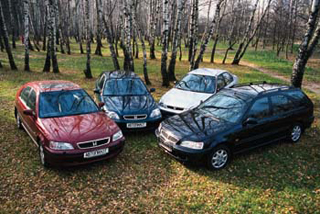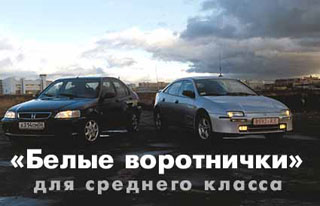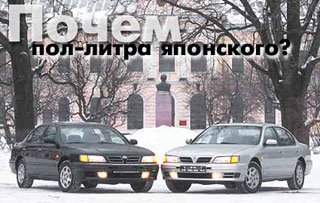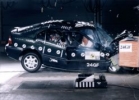Test drive Honda Civic Sedan 1995 - 2000 sedan
Variations
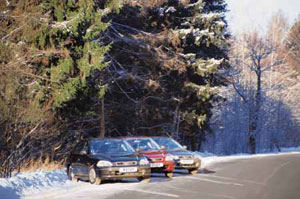 We were sure that after the article in the previous issue we would not have to return to Honda Civic cars for a long time. But here it turned out that for three years already on the market there has been an unusual modification of this popular model with a lack of unavailable variator as a checkpoint. It always seemed to us that the variator is in the lot of low -power equipment: snowmobiles, for example, or very small cars like Subaru Justy (motor #1, 1996). And here is civic, not a limousine, of course, but you can’t call it a crumb ...
We were sure that after the article in the previous issue we would not have to return to Honda Civic cars for a long time. But here it turned out that for three years already on the market there has been an unusual modification of this popular model with a lack of unavailable variator as a checkpoint. It always seemed to us that the variator is in the lot of low -power equipment: snowmobiles, for example, or very small cars like Subaru Justy (motor #1, 1996). And here is civic, not a limousine, of course, but you can’t call it a crumb ... Immediately questions arose like why?. Why should you produce another such exotic version of the mass car? Is the variator so better than a machine gun on which half a world drives? Theoretically, is it better, but in practice? We tried to answer this question by comparing the behavior of the same machines with different boxes by the variator (VKPP) and automatic (automatic transmission). Before the heap, they decided to take a car with a manual box (manual transmission).
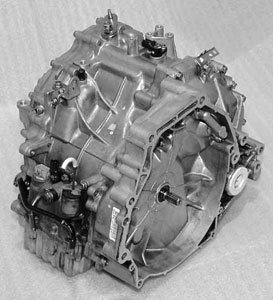 In fact, mechanical unaccounted transmission is not a new product, they were known in the last century. The first frictional mechanisms of this kind consisted of two perpendicular to each other in contacting discs, one of which, at the same time playing the role of the engine flywheel, was a leading, and the other, equipped with a leather rim, led. The driven disc through the pedal moved along the slotted shaft from the center to the edge of the leading disk, while in constant engagement, while its speed changed from zero to maximum. This mechanism replaced both the clutch and reverse.
In fact, mechanical unaccounted transmission is not a new product, they were known in the last century. The first frictional mechanisms of this kind consisted of two perpendicular to each other in contacting discs, one of which, at the same time playing the role of the engine flywheel, was a leading, and the other, equipped with a leather rim, led. The driven disc through the pedal moved along the slotted shaft from the center to the edge of the leading disk, while in constant engagement, while its speed changed from zero to maximum. This mechanism replaced both the clutch and reverse. Such designs were very convenient in work, but were suitable only for low -power equipment and did not differ in durability, which forced to look for other approaches. So a wedge -reproach variator appeared. One of the first such designs was created by engineers of the Dutch company DAF in 1959.
The micro -lunch on which this transmission was used, weighed 600 kg and had a 590 cm cube engine. and with a capacity of 19 hp (4000 vol./Min.). Twisting the moment through the centrifugal clutch and conical transmission was transmitted to two pairs of pulleys connected by a wedge belt (each steam served its leading wheel). Each pulley consisted of two plates that could move and move apart, thereby changing its working diameter and, accordingly, a general gear ratio.
The control of the movement of plates was quite cunning. With an increase in the speed of the car, the centrifugal regulator shifted the plates of the drive pulley, thereby increasing its diameter and reducing the gear ratio. The vacuum cylinder acted on plates, which changed their position depending on the vacuum in the absorption collector corresponding to the position of the throttle. In addition, the position of the plates of pulleys has changed depending on the resistance of the car, i.e. road conditions.
Despite the adverse conditions of the power transmission that allowed the ingress of water and dirt, DAF guaranteed the operation of belts for 30 thousand km ...
Until recently, the main disadvantages of the variators were the impossibility of transferring a large torque and a relatively short service life. The situation has radically changed after Van Doorn Transmission (Holland) has created a reliable plate metal belt. After that, the endless variator ceased to be the destiny of only low -power mechanisms and began to appear on cars with more and more powerful engines.
Such a belt is also used in the unavailable Multi Matic variator, which Honda worked on for ten years. The belt is a set of steel trapezoidal plates 1.5 mm thick, clamped between two steel, closed into the ring with ribbons. The Honda Civic VKPP he equipped with a torque of 140 Nm. The gear ratio smoothly changes in the range of 2.47-0.457. CVT control pure electronics. The company claims that thanks to the perfect selection of the gear ratio in each specific situation and low losses in the transmission, close to losses in the manual transmission, the variator in urban conditions provides 15% of the lower fuel consumption than the automatic transmission.
The durability of the design to some extent is evidenced by the instruction that recommends the first 200 thousand km of the run to change the liquid in the CPSU.
One of the features of the VKPP under consideration is the use of a wet multi -disable coupling installed on the secondary transmission shaft. It acts as a clutch mechanism and admits, in contrast to other similar mechanisms (used, in particular, in automatic transmission), prolonged slipping of the friction discs. The combination of electronic control and a multi -disable coupling provides the same smoothness of the beginning of movement and small speed in the road traffic jam, as well as the automatic transmission of the automatic transmission.
The dynamic indicators of the CPSU given by the Honda speak for themselves: at a 400-meter distance when accelerating from a place, a car with a variator is ahead of rivals with a machine gun and mechanics, respectively, 1.7 and 0.1 seconds, respectively.
An interesting feature of the CPSU is the ability to work in emergency mode, without the participation of electronics. If the brains suddenly refuse, you just need to disconnect the electric connector from them. In this case, the pulleys will take a position that corresponds to the overdrive mode, and the touch from the place and acceleration will be carried out only due to the slipping of the clutch, the closing force of which depends on the pressure developed by the oil pump, and therefore on the engine speed.
It is funny that the speed of reversing in the emergency mode increases, and in this case the car can theoretically be dispersed to the same speed as when moving forward (with normal operation of the VKPP in the movement of the variator pulleys, they remain in the position of the greatest gear ratio).
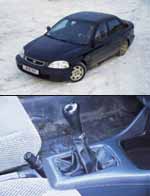 In this case, the same machines are, first of all, the identity of the engines, the types of bodies play not such an important role. However, it quickly became clear that it would not be possible to find cars with completely identical motors, since only a specially unclenched (to reduce the number of revolutions of the maximum torque) is put on the variator version) an engine with a volume of 1.6 liters. I had to take cars with 1.5 liters of motors, however, in terms of power from the engine of the variator Civic, they did not differ, and in the torque they were slightly inferior. All engines had electronic multi -point injection, four valves per cylinder and changed depending on the gas distribution phase.
In this case, the same machines are, first of all, the identity of the engines, the types of bodies play not such an important role. However, it quickly became clear that it would not be possible to find cars with completely identical motors, since only a specially unclenched (to reduce the number of revolutions of the maximum torque) is put on the variator version) an engine with a volume of 1.6 liters. I had to take cars with 1.5 liters of motors, however, in terms of power from the engine of the variator Civic, they did not differ, and in the torque they were slightly inferior. All engines had electronic multi -point injection, four valves per cylinder and changed depending on the gas distribution phase. Before us is a silver three -door hatchback with the CPSU, it will be necessary to drive around the city there, cars with automatic and mechanical transmission are waiting for us there.
Externally, the handle of control of the box is like a regular machine, the same floor lever with a T-shaped head. And the designations are the same: P (parking), R (rear passage), N (neutral), D (movement), S (sport), L (low). The clutch pedal is naturally absent. Switching the modes when the car moves forward is carried out on the go, while only the electronics algorithm changes (this cannot bring this to the variator breakdown).
The handle is in position P otherwise, the key to the ignition lock cannot be inserted (and not pulled out), but you can start the engine in position P or N. So far, everything is as usual. To activate the variator box, you, releasing the accelerator, step on the brake pedal, and then, by pressing the clamp button on the VKPP lever, transfer it to the required position. D. D. Mode ...
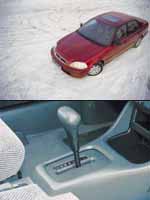 Immediately fall into the cork. Cars are barely weaving, often they stop at all. It is quite acceptable to relax, turn on the music ... only the leg works slightly on the brake. If you let it go, Civic begins a leisurely move forward. Any differences from a car with automatic transmission are not yet noticeable. Manipulations of the lever of the box are produced without looking at everything very similarly at the control of the automatic, in addition, the selected mode resembles the instrument shield.
Immediately fall into the cork. Cars are barely weaving, often they stop at all. It is quite acceptable to relax, turn on the music ... only the leg works slightly on the brake. If you let it go, Civic begins a leisurely move forward. Any differences from a car with automatic transmission are not yet noticeable. Manipulations of the lever of the box are produced without looking at everything very similarly at the control of the automatic, in addition, the selected mode resembles the instrument shield. After the next traffic light, there was an opportunity to accelerate, and then surprises began. In mode D, at about a speed of 40 km/h, the turnover according to the testimony of the tachometer crawl up, then the arrow freezes 2000 rpm. And further adding of gas does not affect it. Moreover, as soon as the speed of the car stabilizes, the revolutions fall a little the motor goes into an economical mode, as the indicator light informs. When the gas pedal is released, the engine is inhibited by the engine that is common for a mechanical transmission, but not always found in machines with an automatic box.
It feels like leading a trolleybus so much depends on the speed of the machine on the movement of the gas pedal. All the actions of the variator are impeccable, there are no delays and internal switches (characteristic of some automatic machines).
We go to the suburban highway and you can frolic. On the go, I transfer the selector to the position of S and press the floor of the gas pedal. The tachometer arrow almost instantly jumps to the mark of 6500 vol./Min. (maximum power revolutions), while the pulleys retain the highest gear ratio until the machine gains 60 km/h, and only after that (with unchanged engine speed) the variator begins to play with diameters. The dynamics of acceleration is just crazy. You enjoy acceleration, and before your eyes a thin metal strap between the pulleys, you wait subconsciously: it is about to start slipping or completely burst ...
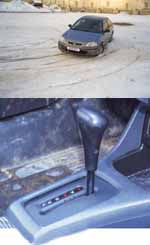 Outside the city, we are met by two other Civic, different colors (so as not to get confused): a red sedan with a 4-speed automatic transmission, black with a 5-speed manual transmission. With a direct comparison, our primary diagnosis was confirmed by dynamism, the variator machine at the first hundreds of meters was furnished not only automatic, but also mechanical. However, this should be so with discreteness of the values \u200b\u200bof transmitting relations in the automatic transmission and manual transmission and manual transmission, it is impossible to maintain the value of the torque at the maximum level all the time, but the variator allows this.
Outside the city, we are met by two other Civic, different colors (so as not to get confused): a red sedan with a 4-speed automatic transmission, black with a 5-speed manual transmission. With a direct comparison, our primary diagnosis was confirmed by dynamism, the variator machine at the first hundreds of meters was furnished not only automatic, but also mechanical. However, this should be so with discreteness of the values \u200b\u200bof transmitting relations in the automatic transmission and manual transmission and manual transmission, it is impossible to maintain the value of the torque at the maximum level all the time, but the variator allows this. Understanding that under ordinary conditions the difference in the behavior of cars with a variator and a good automatic can be not very noticeable, we tried to provoke an extraordinary situation. The ice platform, which was tagged to the brilliance, is proposed to move out of the place ... The most delicate circulation demanded, of course, the car with the manual transmission cost a little to be mistaken with the clutch or gas pedal, and the wheels began to slip. The machine and the variator smoothly took the cars from the place, it was worthwhile to release the brake pedal. But if the driver nevertheless gasped, then these boxes were mistaken unwound the wheels to slip.
Safe driving on a slippery road, of course, contributes to the possibility of braking by the engine. There is a clear priority for cars with manual transmission and VKPP. The Honda automatic box also allows but not in all modes.
The identity of the chassis of three machines made it possible to evaluate the convenience of control in the light of the features of the boxes. Here, the mechanics took an honorable third place because it required constant attention. The machine and the variator made it possible to completely forget about the transmission, and focus on the steering, but the actions of the All -Union Communist Party of the CCP were more logical. On slippery coating, an unshakable ABS prevented to concentrate, which now and then strove to help the driver, but still the variator seemed preferable to the automatic transmission and even mechanics.
So, according to the totality of indicators, the victory won Civic with a variator, Civic with automatic transmission in second place. (Athletes adherents of mechanical boxes will surely dispute the last place of the car with the manual transmission. But the Honda Civic is a regular car for the city, and in this case, the manual transmission, requiring constant manipulations in the city slalom by lever and clutch, is the least convenient for whatever they say. In addition, we recall that we took the car with mechanics only to the heap.)
 The advantages of the variator compared with the automatic transmission are improved dynamic characteristics and efficiency of the car, the possibility of braking by the engine, constructive simplicity. The disadvantages include the restriction on the mass of the towed trailer, a lower maximum speed and most importantly the novelty of the product, which is why sufficient data on its reliability and durability are not yet available. The instruction for the car comforts, which says that the first 200 thousand km of run is only required to change the liquid in the CPSU. The control opening of the variator after several tens of thousands of kilometers was shown by the lack of visible traces of wear of the belt and pulleys. And what will happen, say, in 300 thousand?
The advantages of the variator compared with the automatic transmission are improved dynamic characteristics and efficiency of the car, the possibility of braking by the engine, constructive simplicity. The disadvantages include the restriction on the mass of the towed trailer, a lower maximum speed and most importantly the novelty of the product, which is why sufficient data on its reliability and durability are not yet available. The instruction for the car comforts, which says that the first 200 thousand km of run is only required to change the liquid in the CPSU. The control opening of the variator after several tens of thousands of kilometers was shown by the lack of visible traces of wear of the belt and pulleys. And what will happen, say, in 300 thousand? Now about the price. The equipment of all machines turned out to be approximately the same close to the maximum possible, therefore they are much more expensive than basic versions. Direct comparison is difficult, but it is clear that the variator is somewhat more expensive than the machine gun.
Hatchback with a variator $ 21.900
Sedan with a machine gun $ 21.600
Sedan with mechanics $ 20.600
Maintenance of the CPSU and automatic transmission is reduced to the periodic replacement of working fluids. The liquids are different, but the price is one (about $ 19 per liter). 3.9 liters are poured in the CPSP, and in the automatic transmission 2.7 liters. Flip replacement in the variator is carried out after 45,000-70,000 km of run, in the machine in 40,000 km. The cost of the procedure is the same $ 20. Choose ...
Alexey Strelkov
Source: Motor magazine [No. 03/99]
Honda Civic Sedan 1995 test drives - 2000
Honda Civic Crash Test Sedan 1995 - 2000
Krassh Test: Detailed Information18%
Driver and passengers
3%
Pedestrians





